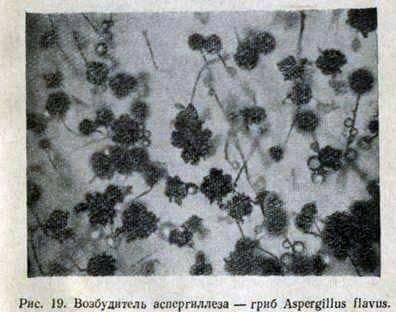
Aspergillosis (stone brood) is an infectious disease of bee colonies, causing the death and drying of the brood and adult bees.
Aspergillosis is dangerous for humans and pets. The development of the disease contributes to high humidity in the area where the apiary is located, abundant pollen gathering and rainy summer.
The causative agent is Aspergillus flavus and Asp. niger. Aspergillus fungus consists of mycelium and fruiting bodies. Mycelium rises above the surface of the nutrient medium to a height of 0.4-0.7 mm and bears clavate light thickenings – fruiting bodies.

The latter are almost round and have a diameter of 30-40 microns. The surface of the fetal bodies is strewn with sterigms, radiating radially in all directions and measuring 6×20 microns. Conidia, or spores (exospores), located in the form of chains, rest on the sterigm. The dimensions of conidia (spores) are 5×7 microns. Their body consists of a protoplasm refracting light, covered with a warty, envelope. The fetal body of aspergillus together with conidia reaches in diameter about 90 microns.
The usual causative agent of the disease is Asp. flavus and rarely Asp. niger – grow on all common nutrient media at a temperature of 7 to 40 њ with an optimum of 20-35 њ. The extreme values of the concentration of hydrogen ions in the nutrient medium are between pH 2.8-7.4, and the optimum pH is 3.1-4.
Exciters strict aerobes; light does not influence the growth of the fungus.
Colonies Asp. flavus greenish-yellow, fine-grained, Asp. The niger is dark brown. The pigments formed by the fungi are insoluble in water. Mushrooms quickly dilute gelatin, coagulate and peptonize milk. On the potato form more pronounced pigments. Aspergillus has enzymes that break down proteins, polysaccharides (starch, glycogen), disaccharides (lactose, sucrose, maltose) and monosaccharides (glucose, levulose, galactose), as well as alcohol, forming a large amount of acid.
Aspergillus secretes heat-resistant toxins that act on the nervous and muscular tissues, the introduction of which into the blood of warm-blooded animals and insects causes seizures and then death.
The causative organism dies when heated to 60 њ for 30 minutes, quickly kills from the mercuric chloride in a dilution of 1: 1000, 2-5% phenol solution, 5% formalin solution.
Epizootic data. The causative agent of the disease is pathogenic for bees (brood and adults), silkworm, oak silkworm, many species of wild insects, warm-blooded animals and in some cases for humans.
Aspergillus is widespread in nature, they live and reproduce on various organic dead substrates, as well as on plants, including stamens of flowers and nectaries. In the beehive aspergillas are recorded by bees with nectar and pollen, where, in the presence of increased moisture, they develop on honeycombs, in perge and in dead bees.
The course and symptoms of the disease. The disease occurs in the form of sporadic cases in individual families. It develops in the family with an abundant supply of bee pollen to the beehive. Damp rainy weather also contributes to the spread of the disease. The most common is the disease in apiaries, located in shaded areas, on damp soil.
Aspergillosis affects the brood of all ages and adult bees. Often pupae are affected. The corpses of larvae and pupae harden, become wrinkled and smaller in volume. In adult larvae, the upwardly turned lateral surface dries up, and the wrinkles that make up give the corpse a curved shape.
In diseased insects, the intensity of oxygen absorption increases tens of times, in parallel there is a loss in weight. The dead insects quickly harden, the mycelium of the fungus grows through the skin in the form of a ring behind the head, forming a kind of collar. Within 1-2 days the fungus spreads over the chitinous cover and forms a white shell consisting of a mycelium. Later, the larvae acquire yellow, green or black color, depending on the type of aspergillus.
When bees remove mold from dried larvae (mummies), they become lighter, and if bees cover the mummies with propolis, then the latter become brown. The dry corpses of the larvae lie in the cells freely and are easily removed.
Adult bees suffer from aspergillosis most often in early spring. When they get sick, they become restless, sharply increase the respiratory movements of the abdomen; soon bees weaken, easily break from the walls of the hive and honeycomb. Sick bees perish in a hive or near a hive. Usually they fly out of the hive and crawl away from it. In such cases, the disease can be overlooked.
When squeezing the belly of a sick bee, a hardening is felt between the fingers. The abdomen becomes even harder a few hours after the death of the bee.
Diagnosis. Aspergillosis is established according to the external signs of the dead brood or adult bees, and also on the basis of microscopic and mycological studies.
Prevention. Hives with bee colonies should be planted in dry places, well lit by the sun. In the apiary it is necessary to keep strong families in tight, well insulated nests.
Control measures. From sick families, honeycomb leaves with affected brood are removed, as well as honeycomb covered with mold. Cells with bees are rearranged to another, clean, dry, disinfected hive. In the hive, replace all the warming material and canvas. The family is provided with sufficient supplies of benign honey.
In the absence of honey, bees are fed with 67% sugar syrup. Weak families underpin and hold in a compressed nest, which is well insulated from the sides and from above. The method of specific treatment is not developed.
Care should be taken when combating aspergillosis. To avoid infection, beekeepers should wear a wet gauze bandage on the nose and mouth.
Цвета для пчел. Как подкармливать пчел.
Diseases of bees